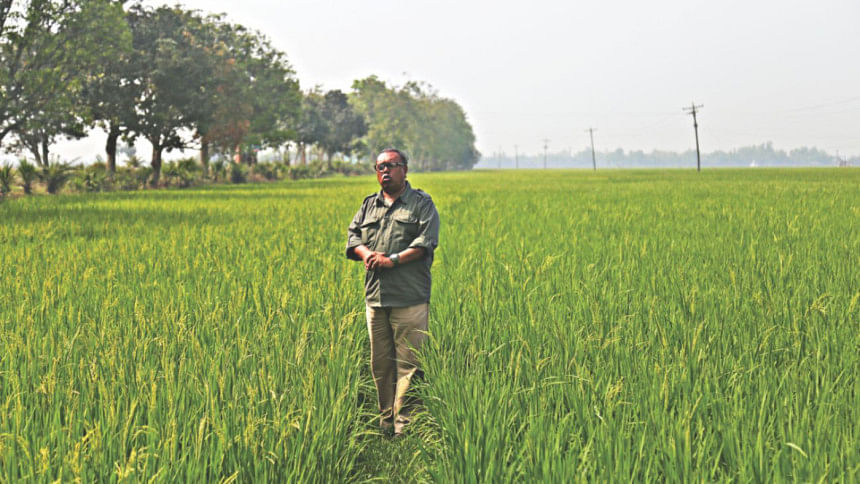What protections for haor crops?

At the moment, there is green vibrancy in rice fields of haor region. Lands after lands across the wide area, rice fields have turned picturesquely green. The only crop of the year, Boro rice is being grown. After one and a half months, the fields will turn golden with ripened rice and the crop will be ready for harvesting. The green colour of paddy this season tells the tale of yet another great production for the nation. However, farmers dreaming of getting this golden crop have doubts on whether they will be able to take it home. Will it submerge again due to a flash flood?
Ali Nur, farmer from Khaliajuri, Netrakona says that his two and a half acres of paddy land went under floodwater last year. He couldn't harvest anything from his golden fields. This is the situation of every haor farmer. Back in 2016, farmers couldn't take their entire crops home. Thousands of hectares of ripe crops submerged. Farmers of Khaliajuri, Shalla, Shamarchar, Mithamoin, Itna, Tahirpur and many other haor areas had to face Nayanbhaga. Even though the word Nayanbhaga sounds nice, only the haor people know how much pain and nature's cruelty are dealt with it. Talking to haor area people, I learned that two kinds of field workers work in the two seasons of paddy planting and harvesting. The ones who work during paddy planting are called Jirati. On the other hand, the ones who do the harvest works, are called Dawali or Bhagali. These field workers are available during the planting and harvesting seasons. When the crops go under water due to untimely floods, these people along with farmers try to save yields as much as possible. They dive in the water to cut paddies. This whole process is called Nayanbhaga.
This flash flood is not a new problem for the haor people. Every year, farmers have a fear that their crops will submerge. Farmers of this area cultivate BRRI 28 or 29. Their lifetime is 140 days and 160 days respectively. Farmers are keen to cultivate BRRI 29 more than the others as it gives more yield. However, it takes half of the month of May for BRRI 29 to be harvested and taken home.

Recently, Director General of International Rice Research Institute (IRRI) Matthew Morell visited Bangladesh and we met for a discussion. I raised the issue of submergence-tolerant rice variety. He said IRRI is experimenting on bringing in a rice variety for haor areas. If everything goes alright, within one or two years, they will be successful in introducing a short-term and high yielding paddy variety. IRRI researcher Dr Md Rafiqul Islam says in many plots of Sunamganj, Kishoreganj and Habiganj, research for a new variety is going on but they couldn't still get an appropriate variety. IRRI, BRRI and many varieties from Nepal are being crossed. If it becomes successful, then they will be able to get a short-term and high-yielding variety with 2-3 years, said Dr Islam.
There was a time when Aus used to be the most popular paddy. The word Aus came from Ashu, which means quick or within a short time. Aus became so popular because of its short-term production feature. I heard that we even had varieties that could be reaped in 60 days. However, those varieties were not high-yielding.
My experience tells that farmers need a variety which is both short-term as well as high-yielding. It is only a matter of time now to make one for the haor people. Technology and modern science can join hands to bring this as soon as possible.
It is evident that haor farmers are becoming victims of climate change. We need to take effective measures to save the farming in haor areas. I wanted to know from Dr Md Rafiqul Islam what more is there to do for the haor farmers. He said that until a new variety is brought in, farmers will need to carry on cultivating BRRI 29 on higher grounds and BRRI 28 on low lands. Researchers need to conduct multidimensional research.
There is another question of adding any alternatives. I talked to globally renowned geneticist Abed Chowdhury. He talked about aquatic paddy which grows with the increase of water and it can be cultivated in waterlogged regions. In China, there is such a variety called Zizania. He also talked about green blue agriculture. Many countries cultivate 'sea-weed' in seaside areas. Besides, water chestnut, wasabi, many kinds of herbs: sage, parsi and different kinds of hydrophytes are also possible to cultivate in haor areas.
An alarming scene is that the construction works of the embankments to protect the haor area is not completed yet. The ones which are being completed in a hurry are more worrying for farmers. Haor people doubt if these embankments of soft soil can actually stop the wild water. Tahirpur's Boyalmara embankment was supposed to be finished by February. Sadly, the construction work started in March. The contractor, Water Development Board, administration -- all blamed each other. Farmers complain that every year construction works for embankments start right before the water comes. In Sunamganj, Tk 122 crore was allocated for 964 projects to make a total of 1,400 km embankments. However, the project wasn't completed in time. The picture remains the same in other haor areas too. After visiting different haor areas, I felt like their farming method is moving far behind technology. They don't use any technology to plant or harvest crops even though they use tractors for ploughing. They could use drum seeder to get planting done in a short time. Similarly, they could use reaper machines to harvest more crops in a little time. Thus technology can curb the loss.
Dear readers, for the protection of farmers' crops and the living of farmers, not only in haor areas but all over Bangladesh, the government should think seriously about crop insurance. There will be more investment in agriculture sector if crop insurance is ensured to provide financial security for the growers. We need to take the haor people along in the road to sustainable development. Public and private research institutions and agriculture extension department have to come forward together not only with a specific plan but with a project with deadline.
Lat the dream that the green crops of haor is showing turn into gold.

 For all latest news, follow The Daily Star's Google News channel.
For all latest news, follow The Daily Star's Google News channel. 



Comments